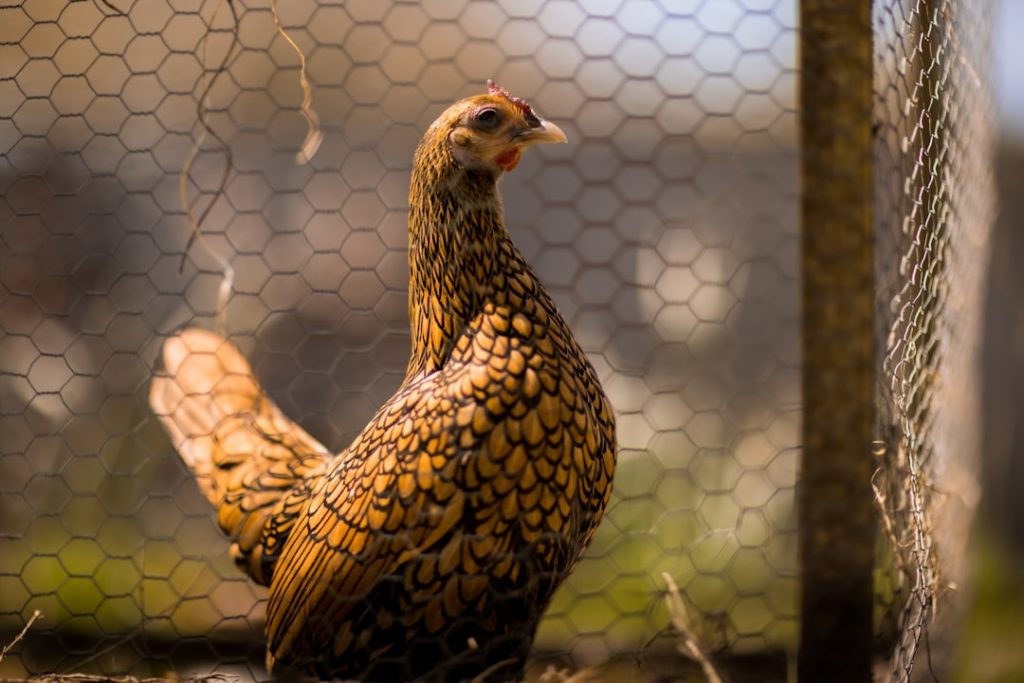The neck of a chicken is a complex anatomical structure comprising seven cervical vertebrae that provide exceptional flexibility and a wide range of motion. This region houses vital components such as the esophagus, trachea, and major blood vessels. Neck muscles support the head and facilitate multidirectional movement.
The cervical vertebrae are interconnected by joints that offer both flexibility and stability for the head. Sensitive sensory organs, including the eyes and ears, are located in the neck area, playing a crucial role in environmental navigation and threat detection. The chicken’s neck anatomy is an evolutionary adaptation perfectly suited to avian needs.
Its flexibility and range of motion enable various behaviors, from foraging to social interactions. The neck is essential for maintaining balance and stability, which is critical for survival. The intricate structure of a chicken’s neck exemplifies the adaptability and complexity of avian anatomy, contributing significantly to the overall health and well-being of these birds.
Table of Contents
Key Takeaways
- The chicken’s neck consists of seven cervical vertebrae, allowing for a wide range of movement.
- Keeping the head still is crucial for chickens to accurately perceive their environment and maintain balance.
- Chickens rely heavily on their vision and hearing to detect predators and find food.
- The vestibulo-ocular reflex helps chickens stabilize their vision while moving their heads.
- Chickens use a combination of visual, vestibular, and proprioceptive cues to maintain balance and avoid predators.
The Importance of Keeping the Head Still
Maintaining Balance and Stability
Keeping the head still is vital for chickens, as it allows them to maintain their balance and stability. When a chicken moves its head, it can disrupt its sense of equilibrium and make it more difficult for them to navigate their environment. This is especially important when chickens are foraging for food or trying to avoid potential predators.
Enhancing Sensory Perception
By keeping their head still, chickens can focus on their surroundings and detect any potential threats more easily. Additionally, keeping the head still allows chickens to use their senses more effectively, as it reduces the risk of sensory overload and allows them to focus on specific stimuli.
Keeping the head still is also important for chickens when engaging in social interactions with other members of their flock. By keeping their head still, chickens can communicate more effectively with their flockmates and maintain a sense of order within the group. This is crucial for maintaining social cohesion and reducing the risk of conflict within the flock.
Overall, keeping the head still is essential for chickens to maintain their balance, navigate their environment, and engage in social interactions with other chickens.
How Chickens Use Their Senses

Chickens rely on their senses to navigate their environment, detect potential threats, and communicate with other members of their flock. Their vision is particularly important, as it allows them to detect movement and identify potential predators. Chickens have a wide field of vision, which allows them to monitor their surroundings for any signs of danger.
They also have excellent color vision, which helps them identify food sources and navigate their environment more effectively. In addition to vision, chickens also rely on their sense of hearing to detect potential threats and communicate with other members of their flock. Their hearing is particularly sensitive to high-pitched sounds, which can alert them to the presence of predators or other dangers.
Chickens also have a highly developed sense of touch, which allows them to navigate their environment and interact with other members of their flock. They use their beaks and feet to explore their surroundings and manipulate objects, such as food or nesting materials. This sense of touch is crucial for their survival, as it allows them to find food, build nests, and engage in social interactions with other chickens.
Overall, chickens rely on a combination of senses to navigate their environment, detect potential threats, and communicate with other members of their flock.
The Role of the Vestibulo-Ocular Reflex
The vestibulo-ocular reflex (VOR) plays a crucial role in helping chickens maintain balance and stability. This reflex allows chickens to keep their eyes focused on a specific point in space while their head is in motion. When a chicken moves its head, the VOR automatically adjusts the position of its eyes to compensate for the movement, allowing them to maintain a stable visual field.
This is essential for chickens when navigating their environment or detecting potential threats, as it allows them to keep their eyes focused on specific stimuli without being disrupted by head movement. The VOR also helps chickens maintain their sense of equilibrium when moving their head, as it allows them to keep their visual field stable and reduce the risk of disorientation or dizziness. This is particularly important when chickens are foraging for food or trying to avoid potential predators, as it allows them to maintain their balance and stability while moving their head.
Overall, the VOR plays a crucial role in helping chickens maintain their balance and stability while navigating their environment and engaging in various behaviors.
How Chickens Maintain Balance
Chickens maintain balance through a combination of sensory input and motor control. Their sense of equilibrium is regulated by the vestibular system, which consists of fluid-filled canals in the inner ear that detect changes in head position and movement. This information is then relayed to the brain, which processes it and sends signals to the muscles to adjust posture and maintain balance.
Chickens also rely on visual input to help them maintain balance, as they use visual cues to orient themselves in their environment and detect potential threats. In addition to sensory input, chickens also rely on motor control to maintain balance. They use their muscles to adjust posture and make small movements that help them stay upright and stable.
This combination of sensory input and motor control allows chickens to maintain balance in a wide variety of situations, from foraging for food to avoiding potential predators. Overall, maintaining balance is crucial for chickens’ survival, as it allows them to navigate their environment effectively and engage in various behaviors without risking injury or disorientation.
The Connection Between Head Movement and Predation

Reducing the Risk of Predation
By keeping their head still, chickens can reduce the risk of attracting predators’ attention and increase their chances of avoiding predation. This allows them to focus on their surroundings and detect potential threats more effectively, which is crucial for their survival in the wild.
Survival in the Wild
Keeping the head still enables chickens to monitor their environment for any signs of danger and take evasive action if necessary. This is essential for their survival, as it allows them to respond quickly to potential threats and avoid becoming prey.
Ensuring Safety
By keeping their head still, chickens can increase their chances of avoiding predation and ensure their safety in their natural habitat. This simple yet effective strategy is vital for their survival and allows them to thrive in their environment.
The Evolutionary Advantage of Keeping the Head Still
The evolutionary advantage of keeping the head still lies in the increased chances of survival for chickens in the wild. By keeping their head still, chickens can reduce the risk of attracting predators’ attention and increase their chances of avoiding predation. This behavior has likely been selected for over generations of natural selection, as it provides a clear survival advantage for chickens in their natural habitat.
Additionally, keeping the head still allows chickens to use their senses more effectively, as it reduces the risk of sensory overload and allows them to focus on specific stimuli. This is crucial for detecting potential threats and navigating their environment more effectively. Overall, the evolutionary advantage of keeping the head still lies in the increased chances of survival for chickens in the wild, as it allows them to avoid predation and navigate their environment more effectively.
In conclusion, the anatomy of a chicken’s neck plays a crucial role in its ability to maintain balance and stability while navigating its environment. Keeping the head still is essential for chickens’ survival, as it allows them to focus on their surroundings, use their senses more effectively, and reduce the risk of attracting predators’ attention. The evolutionary advantage of keeping the head still lies in the increased chances of survival for chickens in the wild, as it allows them to avoid predation and navigate their environment more effectively.
Overall, understanding the importance of keeping the head still provides valuable insight into the behavior and survival strategies of these remarkable birds.
If you’re interested in learning more about the care and housing of chickens, you might want to check out this article on how big a coop needs to be for a chicken. It provides valuable information on creating a comfortable and spacious living environment for your feathered friends.
FAQs
What does it mean that chickens keep their head still?
Chickens have a unique ability to keep their head still while their body moves. This is known as “head stabilization” and allows them to maintain a stable visual field while moving.
How do chickens keep their head still?
Chickens use a specialized visual system that includes a combination of eye movements and head stabilization reflexes to keep their head still while their body is in motion. This allows them to focus on objects in their environment without the visual disruption caused by body movement.
Why do chickens keep their head still?
Chickens keep their head still to maintain a stable visual field and accurately perceive their surroundings while moving. This ability is important for their survival in the wild and helps them navigate their environment and detect potential threats.
Is head stabilization unique to chickens?
Head stabilization is not unique to chickens and is also observed in other bird species. This ability is a common adaptation among birds that allows them to maintain visual stability while in motion.
Can humans keep their head still like chickens?
Humans do not have the same level of head stabilization as chickens and other birds. While humans can focus on objects while moving, their visual system is not as adept at maintaining a completely still head while in motion.
Meet Walter, the feathered-friend fanatic of Florida! Nestled in the sunshine state, Walter struts through life with his feathered companions, clucking his way to happiness. With a coop that’s fancier than a five-star hotel, he’s the Don Juan of the chicken world. When he’s not teaching his hens to do the cha-cha, you’ll find him in a heated debate with his prized rooster, Sir Clucks-a-Lot. Walter’s poultry passion is no yolk; he’s the sunny-side-up guy you never knew you needed in your flock of friends!







